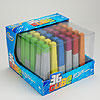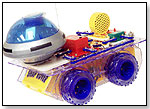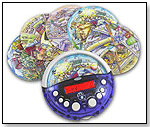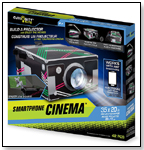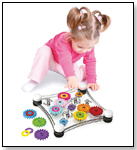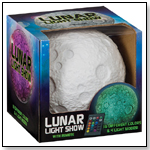|
|
Turning Electronic Appeals Into Specialty Deals How to Sell More Through a Category You Don’t Carry
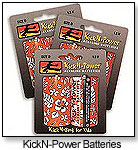 “We don't carry a lot of things that require batteries. The defective rates happen to be a lot higher than things that don’t,” said Michael Temke, buyer for Wind Up Here in Olympia, Wash., of the quality concerns steering him toward classic reliability. “We don't carry a lot of things that require batteries. The defective rates happen to be a lot higher than things that don’t,” said Michael Temke, buyer for Wind Up Here in Olympia, Wash., of the quality concerns steering him toward classic reliability. “We’re more for things that are kid-initiated. They’ve got to make it work,” added Wallace Harvey, owner of Three Cheeky Monkeys in Los Angeles, Calif. Sallie Kashiwa of Timbuk Toys in Denver agreed that electronics should not be a focus. “We feel that electronics are only appropriate in specialty when electronics are needed to enhance the learning or offer a quality that cannot be had without electronics, like sound for phonics. Otherwise, we feel that play should be powered by imagination.” Whether the reason is quality, philosophy, personal preference, or not wanting to compete with the electronics-rich mass market, don't turn an electronics-seeking customer away. Here are tips for times when customers request a product you simply don’t carry: 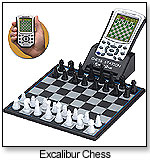 1. Start a Conversation. Find out why the customer is looking for that particular item for the child, and guide them toward products tailored to their interests. “We ask questions about what they're looking for and what the child likes to do. Then we make recommendations,” said Cathy Albro, owner of Creative Learning Toys in Grand Rapids, Mich. 1. Start a Conversation. Find out why the customer is looking for that particular item for the child, and guide them toward products tailored to their interests. “We ask questions about what they're looking for and what the child likes to do. Then we make recommendations,” said Cathy Albro, owner of Creative Learning Toys in Grand Rapids, Mich.2. Go for Like Products. “I just find out what kind of a game they’re looking for, and try to take them to the non-electronic version of whatever it is. If it’s a brainteaser, we have games from ThinkFun; if it’s an electronic chess game, I’ll take them to the regular chess games,” Rebecca Pfeil, owner of Timeless Toys in Homer, Alaska, told TDmonthly.  3. Substitute Active Play. Recommend “a ‘doing’ sort of thing, like lots of different juggling, arts and active [toys],” suggested Tina Schwindt, owner of Fairhaven Toy Garden in Bellingham, Wash. “Not necessarily outdoor, but something that they can use their hands with.” 3. Substitute Active Play. Recommend “a ‘doing’ sort of thing, like lots of different juggling, arts and active [toys],” suggested Tina Schwindt, owner of Fairhaven Toy Garden in Bellingham, Wash. “Not necessarily outdoor, but something that they can use their hands with.”4. Get Into Games. Thirty percent of retailers said they usually direct customers to their game department, favoring the child's interaction with the product and other people over electronically initiated play. “We still do the traditional board games … family games that include more than one person,” said Greg Bonner, owner of Heights Toy Center in Little Rock, Ark. 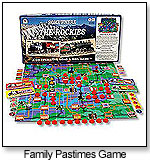 5. Find Interaction. “We recommend toys where the kid’s in charge of the play instead of the toy being in charge,” said Mary Sisson, owner of Kazoodles in Vancouver, Wash. “We try to find alternatives that will exercise kids’ brains or bodies or whatever seems to fit the bill.” 5. Find Interaction. “We recommend toys where the kid’s in charge of the play instead of the toy being in charge,” said Mary Sisson, owner of Kazoodles in Vancouver, Wash. “We try to find alternatives that will exercise kids’ brains or bodies or whatever seems to fit the bill.” If they simply must have something with a current, retailers said they often do good business with handheld games and brain teasers such as Radica's 20Q, or open-ended educational products, such as Elenco's popular Snap Circuits line. In any case, retailers feel that the opportunity to provide their unique service and expertise results in a good experience for the customer. “We build on imagination and family fun,” concluded Susan Castor, owner of Pentwater Toy Box in Pentwater, Mich. “We show them something and they almost always buy something.” See products mentioned in the article below:
 Writer's Bio: Marie Raven has a long history with the specialty toy industry as a family business. In addition to freelancing for TDmonthly Magazine, she writes creative and technical material for various other businesses. Read more articles by this author Writer's Bio: Marie Raven has a long history with the specialty toy industry as a family business. In addition to freelancing for TDmonthly Magazine, she writes creative and technical material for various other businesses. Read more articles by this author |
|
Disclaimer Privacy Policy Career Opportunities
Use of this site constitutes acceptance of our Terms of Use.
© Copyright 2025 PlayZak®, a division of ToyDirectory.com®, Inc.

